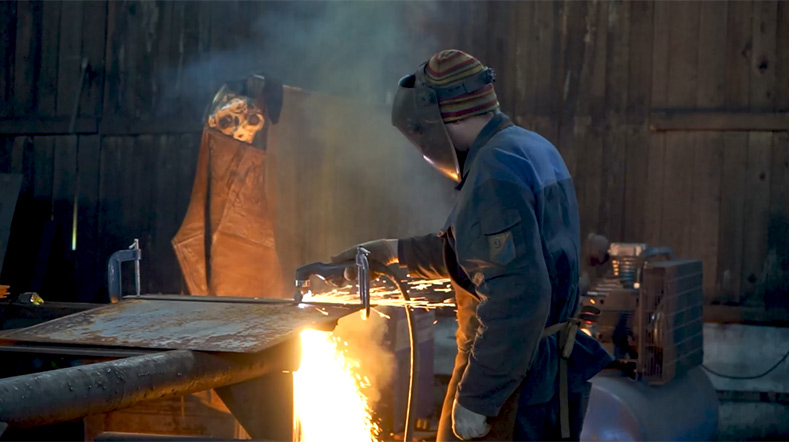
Demonstration of real-time crystalline silica sensor at construction site
Exposure to dust is a common problem in the construction industry. The background concentration of dust at building sites is relatively high and, in addition, workers are exposed to dust caused by their activities. Building materials often contain crystalline silica, a known carcinogenic. TNO is working with construction companies on a sensor that operates in real time and at a high temporal resolution to determine the concentration of crystalline silica to which employees are exposed. The sensor will make it possible to take action immediately where and when needed. TNO has tested the first prototype on a construction site in partnership with construction company Mateboer Groep B.V.
Construction dust may contain many components. One of these is crystalline silica, a very fine dust that is almost if not entirely invisible. It consists of very small, insoluble dust particles that penetrate deep into the lungs and may cause the occupational disease silicosis and lung cancer. Crystalline silica dust is released while processing (e.g. milling, drilling, grinding) quartz-containing materials such as sand-lime bricks, aerated concrete blocks and most natural stones. Although we already know a great deal about how to control dust exposure in the construction industry, it does not always happen in practice.
“A construction site is a dynamic workplace and many activities are one-off and ad hoc. And the fact that sites often have numerous subcontractors working there does not make it any easier to control the dust being produced. The current method of monitoring dust, which averages exposure over the course of a particular day (or part of that day), makes it difficult to establish a relationship between exposure and sources. Identifying that relationship is essential for taking proper exposure control measures in such dynamic environments,” says TNO’s Maaike le Feber.
MONITORING CONCENTRATION IN REAL TIME
Current monitoring methods involve taking samples followed by laboratory analysis. As a result, the level of exposure only becomes apparent long after the work has been done – when it is too late to do anything about it. Current methods offer only limited insights and provide no information about exposure over the course of the day or any peaks in exposure.
“TNO is using sensors and digital technology to develop tools that can detect exposure in real time at a high temporal and spatial resolution.
They will help us understand where and when exposure occurs at a point in time when preventive measures still can be taken. In other words, they’ll make it possible to move from reactive to proactive. One example is the portable sensor that Arjen Boersma and his team at TNO have developed, which allows us to identify dust composition in real time. Our first priority is to determine the crystalline silica concentration in construction dust, but this sensor can also monitor other substances,” says Le Feber. The real-time nature of the sensor comes from our data platform EXCITE, which converts the recorded data into information, that is provided as feedback to the worker in an app.
PARTNERSHIP WITH MATEBOER
“We demonstrated our portable crystalline silica sensor at Mateboer Groep B.V., one of our industry focus group members. After developing a tool in the lab, it’s important to test it in the workplace. We not only tested the tool’s operation in practice, but also the kind of feedback that’s needed,” says Le Feber.
“The Mateboer group considers employee well-being to be of paramount importance. Most workers, and also Mateboer as employer, are concerned about dust and want to do something about it. As a company, we would like to find out more about how the various components of dust in construction impact health. That’s why we were eager to work with TNO,” emphasises Mateboer’s Jan Heite.
“On the test day, we monitored the crystalline silica concentration while various activities were being carried out, including milling the floor and wall, drilling, and sweeping. It was an interesting and instructive day that produced some surprising results.
For example, it was striking how much the concentrations increased when drilling was being carried out on a lower floor. That’s not something you think about on the job. It was also nice during the focus group meetings to see that we share a common cause when it comes to recognising risks, prioritising people’s health and taking steps,” says Heite. “It was enormously valuable for us to work with the focus group and carry out the tests at Mateboer,” adds Le Feber. “We want our sensor to fit the needs of companies. That’s why we do it.”
CREATING AWARENESS & DEVELOPING A WEARABLE
The TNO sensor reveals concentrations of crystalline silica dust and that in itself can help create awareness. “But that’s only part of it. We have to put the data we have collected to good use. Our work doesn’t end because we’ve made the problem visible – we also want to help the sector solve the problem. It’s in any case good to see that companies recognise it and want to move towards a healthier working environment,” says Le Feber.
The portable sensor is the size of a small shoebox. “But we’re working on miniaturising the sensor into a wearable. We expect to have a wearable prototype in 2022.
In addition, we’re continuing to improve the interpretation of the recorded data and the feedback we can give users. Key challenges include linking exposure data to activities – what causes exposure and where should you therefore intervene – and making the invisible visible – how do the concentrations of dust and crystalline silica vary across the building site and over time,” Le Feber explains. “Once this tool has been refined and a wearable version is available, we definitely intend to use it,” adds Jan Heite.
VOHA
The portable crystalline silica sensor complements TNO’s ideas about the Virtual Occupational Hygiene Assistant or VOHA. We are convinced that continuous monitoring of exposure data offers opportunities for proactive management and targeted prevention.
Want to know more about our crystalline silica sensor or cooperate with TNO on its development? Get in touch with Maaike le Feber.
Get inspired
Pilot study on welding fumes proves the potential of sensor measurements for a healthy workplace


Occupational safety innovation

Smart sensors for a healthy and safe working environment


